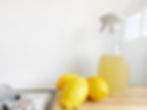Cleaning

Cleaning simply means you remove visible debris, dirt, dust and organizing a space. Cleaning a surface uses soap or detergent and, usually, water to remove soil and germs through chemical (cleaner), mechanical (scrubbing), and thermal (water temperature) action. Cleaning aids in lowering the risk of spreading infectious microbes but does not kill bacteria and germs, but it will dilute their numbers.
Dust and dirt cleaned from surfaces of indoor environments contributes to better health of indoor occupants because allergens and microorganisms are being removed. However, there is a risk of cross-contamination. In the absence of a germicide, the mopping solution and the cleaning tools could be spreading disease.
Sanitize
Sanitizing kills/reducing the number of bacteria present but does nothing about viruses and fungus. Sanitizing is better than cleaning alone but it is better when you disinfect. Sanitizers reduce microorganisms on a surface to a level considered safe by public health standards.
Sanitization is important for health and hygiene and is particularly important on communal surfaces like countertops, doorknobs, light switches, touch pads, and any surface that comes in contact with body fluids. And any surface that comes in contact with food must be cleaned and sanitized.
Disinfecting
Disinfecting kills microscopic organisms (germs, viruses, fungi) on surfaces.
Using EPA-approved chemicals that kill germs, viruses and fungi and prevent them from spreading is our recommended way. Cleaning first is recommended as disinfecting does not remove visible dirt and debris from a surface.

Disinfectants are so potent they classified and handled by the EPA as pesticides. There is a growing public health and environmental concern for the over use and misuse of disinfectants. Some disinfectant products create microbes that can mutate info superbugs that are resistant to that disinfectant.
Disinfecting should always be done when someone in the household is ill or if someone has a compromised immune system. Or people coming in and out of your home. Be sure to follow label instructions when using disinfectants.
Proper ways to Cleaning, Sanitizing, and Disinfecting
Routine Cleaning is the best way to protect your family from infectious diseases. The slight abrasion of the microfiber cloth and the cleaning solution will lift and dilute any microbes that have settled on the surfaces. If someone in your home is ill or has a compromised immune system or there is a widespread viral outbreak in the community, add sanitizing or disinfecting products to your regular cleaning routine.
Read Labels and Follow Directions
Almost all sanitizing and disinfecting products, including the ingredients in wipes, must remain on a surface for four to 10 minutes to effectively kill germs and bacteria. You must use a sufficient amount to keep the surface wet for that entire time and then allow the surface to air-dry.
Products Safely Do not mix chemicals when cleaning. Chlorine bleach, an excellent disinfectant, and ammonia, an excellent cleaner, when mixed together produce a toxic gas that can result in lung damage or death. Always provide adequate ventilation when using any type of cleaning product.

Wear protective eyewear and gloves when using harsh chemicals. And always wash your hands with soap and warm water after handling soiled garments, emptying waste receptacles, and using cleaning products. Household bleach can be used as a sanitizer or a disinfectant, depending on how much it’s diluted (in a lower concentration for sanitizing, in a higher concentration for disinfecting) follow contact time recommendations. Vinegar and essential oils, are becoming popular cleaners, but it isn’t a registered disinfectant or sanitizer and can’t necessarily kill dangerous bacteria.
We recommended using essential oil solutions before or after using bleach.
DIY Homemade Bleach Disinfectant Spray:
4 teaspoons household bleach(5-6%)
1 quart water (hot water not recommended)
Pour both into one quart spray bottle, shake vigorously Spray on surface to disinfect, let sit for 10 minutes, wipe away with wet cloth
Disinfecting with Essential Oils
While all of these seem to be great at killing germs, some of the above oils needed higher concentrations, or only killed certain strains of bacteria and have been used against major illnesses like the Flu and E. coli. They found that the following were most effective:
clove
geranium
lemon
lime
orange
rosemary
cinnamon bark (not leaf-avoid touching skin)
lemongrass thyme (red, wild and geraniol)
peppermint
tea tree
coriander
lavender
Disinfectant Essential Oil Blends:
Peppermint and tea tree
lemongrass and lavender
geranium and lime
grapefruit and lime
grapefruit, lemon and lavender
tea tree and orange

DIY Homemade Essential oil disinfectant(1):
50-60 drops of above essential oils
1/2 cup white distilled vinegar ( more alcohol )
1 1/2 cups 100 proof alcohol (vodka) or higher get the highest proof alcohol you can find (in some states you can buy 190 proof, which is Ever clear, if not at least 100 proof) or at least 70% isopropyl rubbing alcohol. Rubbing alcohol can damage painted and varnished surfaces so it's best to spot test first.
32oz spray bottle
Pour all into one quart spray bottle, shake vigorously
Spray on surface to disinfect, let sit for 10 minutes, wipe away with microfiber cloth.
DIY Homemade Essential oil disinfectant(2):
3/4 cup distilled water
1/4 cup white vinegar(substitute alcohol )
8 ounces spray bottle 7 drops lavender essential oil (or oil of choice)
7 drops tea tree essential oil (or oil of choice)
Pour all into one quart spray bottle, shake vigorously
Spray on surface to disinfect, let sit for 10 minutes, wipe away with microfiber cloth.
The essential oil is added as an antibacterial ingredient. Hydrogen peroxide can also work as a disinfectant when used straight (not diluted with anything and don't mix with vinegar!). Just be careful with hydrogen peroxide as it can bleach colored fabrics.
Comment what your thoughts and best practices for cleaning, sanitizing and or disinfecting are below:
